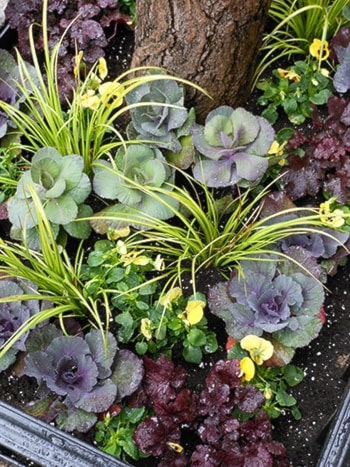Gardening by Brian Minter
It was a wonderful October but our amazing annuals and perennials are now looking very tired. They will make great compost, but removing them will leave your garden looking rather bare. Winter colour plants, set out now, will add new life and provide much needed colour to your winterscape.
Strategically planting winter colour in groups with contrasting blocks of bright colours, like yellow with more pastel shades, creates the most pleasing effect. Groupings of hardy ‘Maribor’ and ‘Winterbor’ kale, winter heather, violas, pansies and bright evergreen foliaged perennials, placed here and there in your garden and close to your walkways, will give a tremendous lift to your winter garden.
It is still the ideal time to plant your fall bulbs. Plant them in well-drained soil at a depth of three times the diameter of the bulb. Plant bulbs in groupings for the most pleasing effect. With proper planning, you can time your bulbs to bloom in sequence from January through June. I’m a big fan of botanical or species bulbs that naturalize easily and come back each year with an even more impressive display. Make sure you have at least a few alliums for a great summer show in eight months time.
It’s the last call for lifting and protecting summer bulbs. Gladiola corms and begonia tubers should have been lifted by now, and they must be kept warm at about 15°C. It is also the time to lift dahlia and canna tubers.
Vegetable gardens:
Many late vegetables can stay in the garden for winter harvesting. These include turnips, parsnips, brussels sprouts, swiss chard and the new series of winter vegetables. Hardy larger Siberian kale can still be planted.
Fall is a great time to add existing compost to your garden, and there is still time to plant Garden Rejuvenation Mix for invaluable green manure in the spring. Speaking of compost, make sure you take full advantage of all the leaves, old annuals and vegetable stems by composting them over the winter. You might also wish to add fine fir or hemlock bark mulch (or sawdust) and sand to your vegetable garden to improve the drainage next year. Applying lime is important now too, except of course where you are going to grow potatoes.
Trees and Shrubs:
Now is the best time to plant most evergreens, fruit trees and shade trees. They are becoming dormant and, once planted, they will immediately form new roots. By spring, they will have well established root systems. Some points to remember:
The quality of the soil in which you plant your new trees will determine how well your trees grow. Work in plenty of fine bark mulch to open up and provide good drainage in our heavy clay soils.
If your trees are in burlap sacks, you should leave the sack on the rootball – it’s holding all those roots together!
Bare root trees can be safely dug and planted as of November 15th. They will make new roots, getting them off to a great start come spring.
Because of the long dry summer, many cedars and pines are dropping brown inside foliage. Simply let it fall, rake it up and compost it. It’s a great time to feed hedging cedars using a quality slow release lawn fertilizer like 32-0-10.
If you use a liquid starter, your trees will get a faster start. Evergreen hedges, planted now, will provide a good windbreak for cold winter winds, thereby helping to keep your fuel bill down.
